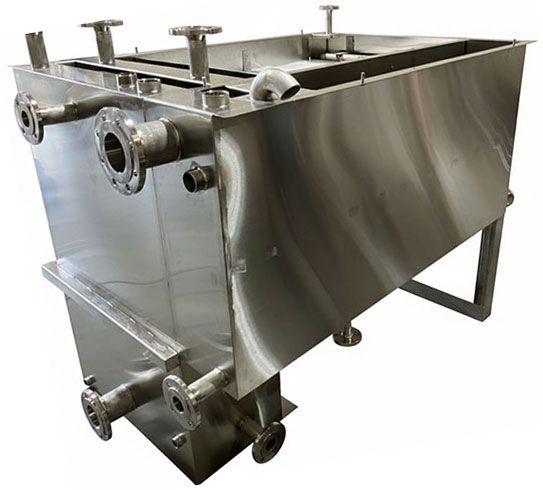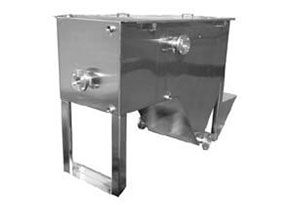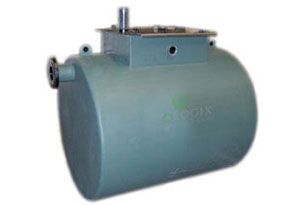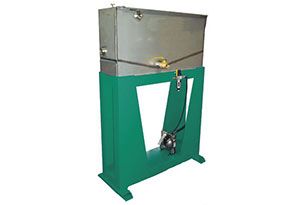Above-ground oil-water separators (OWSs) are essential equipment for many small businesses that generate oily wastewater. These compact, efficient systems help businesses comply with environmental regulations, avoid costly fines, and contribute to cleaner water systems by removing hydrocarbons and suspended solids before discharge.

Application Profile: The Small Vehicle Service & Wash Bay
| Business Type | Small Auto Repair Garage with an On-Site Wash Bay |
| Problem | Washdown water from the service bays and vehicle cleaning area contains oil, grease, diesel, coolants, and dirt/sediment (hydrocarbons and solids). Discharging this directly to the municipal sewer is illegal and causes blockages. |
| Solution | Installation of a Compact Above-Ground Coalescing Plate Oil-Water Separator. |
| System Flow Rate | Low-to-moderate (e.g., 2-20 gallons per minute, depending on the unit size). |
1. Justification for an Above-Ground OWS
The above-ground model was chosen over an underground separator for several reasons critical to a small business:
- Ease of Installation & Relocation: The unit is prefabricated and self-contained, requiring minimal civil work (no major excavation), which significantly reduces upfront installation cost and time. It can also be relocated if the business moves or expands.
- Maintenance Simplicity: Access for inspection, maintenance, and cleaning is straightforward due to the above-ground design and removable covers. This reduces the time and cost for sludge and oil removal, which is typically done by a vacuum truck service.
- Compliance Verification: Visual confirmation of the separation process and collected oil/sludge levels is easy, helping the owner quickly ensure compliance with local wastewater discharge limits (often requiring less than 100 ppm, or in some cases, less than 10 ppm of oil).
2. Separator Technology and Operation
The separator uses coalescing plate technology (often a cross-fluted media design) to enhance the natural gravity separation process:
- Influent Entry: Oily wash water is pumped or gravity-fed into the OWS inlet chamber.
- Solids Removal: Settleable solids like sand and grit drop to the bottom sludge chamber due to gravity.
- Oil Separation (Coalescing): The water flows through the corrugated plates. Oil droplets collide and coalesce (join together) into larger droplets on the plate surfaces.
- Flotation and Skimming: The now larger, more buoyant oil droplets rise rapidly to the water surface, forming a layer of recovered oil that is skimmed into an oil containment chamber for later recycling or proper disposal.
- Clean Effluent Discharge: The treated water flows out of the final chamber and is discharged to the sanitary sewer or further treated for reuse in the wash bay (closed-loop system).
3. Small Business Benefits
| Benefit Category | Impact on the Small Business |
|---|---|
| Regulatory Compliance | Avoided fines and potential operational shutdowns from the local Publicly Owned Treatment Works (POTW) by meeting required discharge limits for hydrocarbons and solids. |
| Cost Reduction | Recovers valuable used oil (e.g., motor oil, diesel fuel) that can be collected and sold or disposed of as less costly non-hazardous waste. Prevents costly sewer line blockages. |
| Operational Efficiency | Provides a reliable, low-maintenance solution with no moving parts or chemicals required for separation, minimizing operational overhead and downtime. The compact footprint allows it to be placed in tight spaces near the wash area. |
| Environmental Stewardship | Protects the local environment (soil, groundwater, and waterways) from pollution, boosting the business's local reputation. |
Other Common Small Business Applications
Above-ground OWS units are versatile and can be used in any small business that produces light, non-emulsified oily wastewater:
- Fleet Maintenance Garages: For small commercial fleets, treating washdown from oil changes and general vehicle servicing.
- Car Detailing Shops: Managing water contaminated with small amounts of wax, polish, and incidental oils.
- Equipment Rental Yards: Cleaning construction or heavy machinery before rental return, where dirt and hydraulic fluid are common contaminants.
- Small Manufacturing/Metalworking: Treating water used in parts washing that contains cutting fluids and lubricants.
Have a project you would like to discuss?
Contact Ecologix Environmental Systems today to learn more about our engineered solutions.
Contact Us

